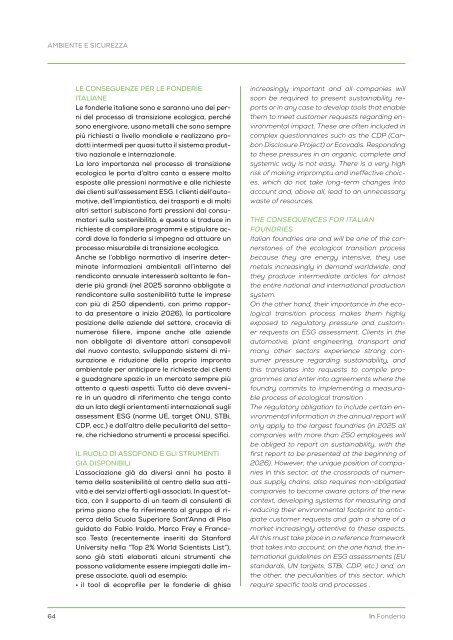In Fonderia 6 2023
Sesto numero del 2023 di In Fonderia
Sesto numero del 2023 di In Fonderia
You also want an ePaper? Increase the reach of your titles
YUMPU automatically turns print PDFs into web optimized ePapers that Google loves.
AMBIENTE E SICUREZZA<br />
LE CONSEGUENZE PER LE FONDERIE<br />
ITALIANE<br />
Le fonderie italiane sono e saranno uno dei perni<br />
del processo di transizione ecologica, perché<br />
sono energivore, usano metalli che sono sempre<br />
più richiesti a livello mondiale e realizzano prodotti<br />
intermedi per quasi tutto il sistema produttivo<br />
nazionale e internazionale.<br />
La loro importanza nel processo di transizione<br />
ecologica le porta d’altro canto a essere molto<br />
esposte alle pressioni normative e alle richieste<br />
dei clienti sull’assessment ESG. I clienti dell’automotive,<br />
dell’impiantistica, dei trasporti e di molti<br />
altri settori subiscono forti pressioni dai consumatori<br />
sulla sostenibilità, e questo si traduce in<br />
richieste di compilare programmi e stipulare accordi<br />
dove la fonderia si impegna ad attuare un<br />
processo misurabile di transizione ecologica.<br />
Anche se l’obbligo normativo di inserire determinate<br />
informazioni ambientali all’interno del<br />
rendiconto annuale interesserà soltanto le fonderie<br />
più grandi (nel 2025 saranno obbligate a<br />
rendicontare sulla sostenibilità tutte le imprese<br />
con più di 250 dipendenti, con primo rapporto<br />
da presentare a inizio 2026), la particolare<br />
posizione delle aziende del settore, crocevia di<br />
numerose filiere, impone anche alle aziende<br />
non obbligate di diventare attori consapevoli<br />
del nuovo contesto, sviluppando sistemi di misurazione<br />
e riduzione della propria impronta<br />
ambientale per anticipare le richieste dei clienti<br />
e guadagnare spazio in un mercato sempre più<br />
attento a questi aspetti. Tutto ciò deve avvenire<br />
in un quadro di riferimento che tenga conto<br />
da un lato degli orientamenti internazionali sugli<br />
assessment ESG (norme UE, target ONU, STBi,<br />
CDP, ecc.) e dall’altro delle peculiarità del settore,<br />
che richiedono strumenti e processi specifici.<br />
IL RUOLO DI ASSOFOND E GLI STRUMENTI<br />
GIÀ DISPONIBILI<br />
L’associazione già da diversi anni ha posto il<br />
tema della sostenibilità al centro della sua attività<br />
e dei servizi offerti agli associati. <strong>In</strong> quest’ottica,<br />
con il supporto di un team di consulenti di<br />
primo piano che fa riferimento al gruppo di ricerca<br />
della Scuola Superiore Sant’Anna di Pisa<br />
guidato da Fabio Iraldo, Marco Frey e Francesco<br />
Testa (recentemente inseriti da Stanford<br />
University nella “Top 2% World Scientists List”),<br />
sono già stati elaborati alcuni strumenti che<br />
possono validamente essere impiegati dalle imprese<br />
associate, quali ad esempio:<br />
• il tool di ecoprofile per le fonderie di ghisa<br />
increasingly important and all companies will<br />
soon be required to present sustainability reports<br />
or in any case to develop tools that enable<br />
them to meet customer requests regarding environmental<br />
impact. These are often included in<br />
complex questionnaires such as the CDP (Carbon<br />
Disclosure Project) or Ecovadis. Responding<br />
to these pressures in an organic, complete and<br />
systemic way is not easy. There is a very high<br />
risk of making impromptu and ineffective choices,<br />
which do not take long-term changes into<br />
account and, above all, lead to an unnecessary<br />
waste of resources.<br />
THE CONSEQUENCES FOR ITALIAN<br />
FOUNDRIES<br />
Italian foundries are and will be one of the cornerstones<br />
of the ecological transition process<br />
because they are energy intensive, they use<br />
metals increasingly in demand worldwide, and<br />
they produce intermediate articles for almost<br />
the entire national and international production<br />
system.<br />
On the other hand, their importance in the ecological<br />
transition process makes them highly<br />
exposed to regulatory pressure and customer<br />
requests on ESG assessment. Clients in the<br />
automotive, plant engineering, transport and<br />
many other sectors experience strong consumer<br />
pressure regarding sustainability, and<br />
this translates into requests to compile programmes<br />
and enter into agreements where the<br />
foundry commits to implementing a measurable<br />
process of ecological transition .<br />
The regulatory obligation to include certain environmental<br />
information in the annual report will<br />
only apply to the largest foundries (in 2025 all<br />
companies with more than 250 employees will<br />
be obliged to report on sustainability, with the<br />
first report to be presented at the beginning of<br />
2026). However, the unique position of companies<br />
in this sector, at the crossroads of numerous<br />
supply chains, also requires non-obligated<br />
companies to become aware actors of the new<br />
context, developing systems for measuring and<br />
reducing their environmental footprint to anticipate<br />
customer requests and gain a share of a<br />
market increasingly attentive to these aspects.<br />
All this must take place in a reference framework<br />
that takes into account, on the one hand, the international<br />
guidelines on ESG assessments (EU<br />
standards, UN targets, STBi, CDP, etc.) and, on<br />
the other, the peculiarities of this sector, which<br />
require specific tools and processes .<br />
64<br />
<strong>In</strong> <strong>Fonderia</strong>














